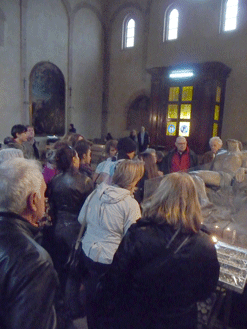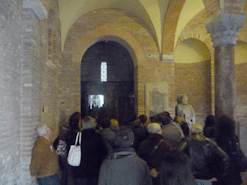The Urban Trekking cultural initiative, organized by the
Municipality of Bologna, offers the public a new understanding of the
beauties of the city, through the guided visits based on dynamic vision of
the artistic heritage and on the active perception of art and its social
and spiritual values.
The Institute for the Blind Francesco Cavazza,
called back to work in collaboration with the City of Bologna for the
second edition of this interesting cultural event, organized a tour
centered on the narrative of art history and contextual haptic exploration
of famous works of art in important churches and museums of Bologna. The
tactile tour, an experience for all citizens and not only dedicated to
people living with vision loss, has created awareness in the public about
subjects such as the quality of perception, the depth of vision, listening
skills in the development of sensory abilities, and oriented a reflection
on the cognitive function of aesthetic education between the tactility of
the eye and the opticality of touch. The visit began at the St. Stephen's
Basilica, where, thanks to the availability of the Olivetan Benedictines
who take care of the sacred place, it was possible to explore through
touch some examples of priceless medieval sculptures. The knowledge of
interior spaces to the group of Seven Churches, the tactile perception of
columns, capitals, parapets and relief sculpture, the kinesthetic
experience related to the distance of corridors and aisles, the dimension
of peacefulness and contemplation in being in the cloisters and courtyards
of the Santo Stefano complex, and finally the profound interiorization of
symbolic values conveyed by proprioceptive and tactile sensations, has
allowed everyone to experience the rapture that binds the paths of beauty
and spirituality, bringing new pilgrims on the traces of the old ones, who
for hundreds of years have crossed the threshold of St. Stephen, Holy
Jerusalem Bononiensis, reading signs and assimilating the symbolic values.

